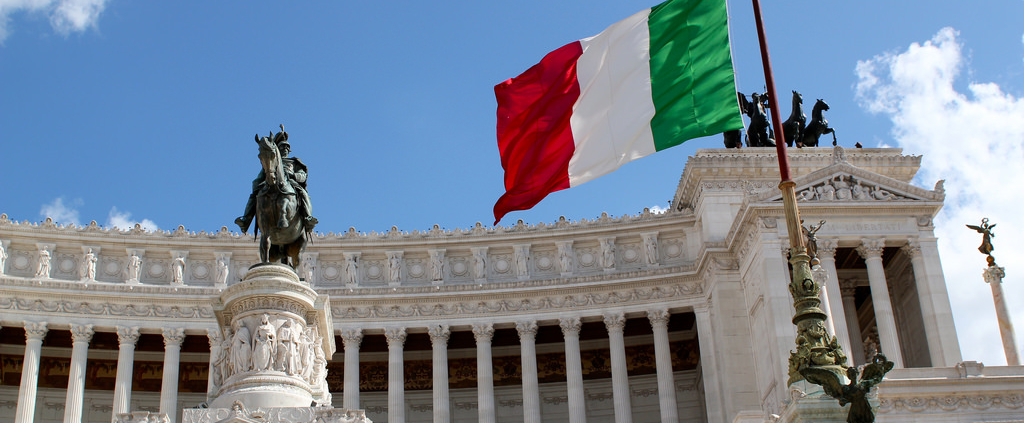Italy’s New Populism, AG Is VIP, and Not So Golden State
Here’s What You Need To Know
After 88 days of political jockeying, negotiations, and drama, Italy’s new populist government was sworn in this month – despite the country’s President threatening not to do so just days prior. Even for Italy’s notoriously complicated, not to mention colorful, political culture, the recent period of uncertainty marked a harrowing trial for the country, which has the third-largest economy in the Eurozone.
Even if you are not an Italy enthusiast or Euro-watcher, the results of this recent election are the latest data point in the worldwide trend of increasing populism and nationalism. How Italy’s new coalition governs, how it works with the European Union, and whether it is deemed successful will impact the global economic, political, and security environments.
Therefore, here is our primer for making sense of the developments that resulted in Italy’s new government, and what to watch for as it begins to follow through on its campaign promises:
Subscribe to Receive Insights
"*" indicates required fields
- Why Did It Take So Long To Form A Government? Italy has a parliamentary system, and after any political group or party failed to capture an outright majority on the March 4th election, protracted negotiations began to form a new coalition that could govern. The two parties with the most votes, the far-right League and the anti-establishment Five Star Movement, reached an agreement in principle early last month on a program called the “Government of Change.” While both parties are traditional political opponents, both are populist in nature and blame Europe and the political class for Italy’s challenges, causing Italian President Sergio Mattarella to reject the coalition’s attempt to form a government last week when an academic who helped write a guide to leave the euro was proposed by the coalition for finance minister. After threatening to call another round of elections and revising their slate of ministers to win President Mattarella’s approval, the new government was sworn in on June 1st.
- The Key Players In The New Government: The three key leaders of the new government are relative unknowns who together represent an entirely new direction for Italy. Technocrat Giuseppe Conte, who has never held political office and embellished parts of his resume, serves as Prime Minister after having been a law professor. Thirty-one year old millennial Luigi Di Maio is the leader of the Five Star Movement, and serves as the Minister of Economic Development, Labour, and Social Policies in the new government. Five years ago, De Maio was living at home, and his lack of a professional job resulted in his being described by the media as a “former waiter” in the lead-in to the March election. Lastly, Matteo Salvini – who is described as “Italy’s Donald Trump” – is a Eurosceptic and leader of the League, who has taken a hardline on immigration. He serves as Minister of the Interior.
- What Are The Government’s Policy Goals? In his first speech to the country, Prime Minister Conte vowed “radical change” while flanked by De Maio and Salvini. Among the government’s priorities are to cut assistance to asylum seekers, crackdown on immigration, implement measures for a system of universal basic income, and reduce Italy’s public debt, which at 130 percent of economic output is the biggest debt burden of major countries in the Eurozone, through wealth creation, not austerity. The coalition will also seek to negotiate changes to the European Union’s fiscal rules impacting Italy, and is seeking to improve relations with Russia by, among other steps, calling for a review of sanctions levied against it over aggression in Ukraine, at the same time Italy reaffirms its commitment to NATO and alliance with the United States. With such an ambitious agenda that appears to straddle both sides of the issues, it remains to be seen what – if anything – the government will be able to achieve.
- What Does This Mean For Europe? German Chancellor Angela Merkel, whose country is the largest economy in the EU, has already made clear that she views the new Italian government as bound by existing EU frameworks, and raised the specter of Greece – a veiled threat, gingerly delivered to avoid increased anti-German sentiment. This message was effective, as the coalition walked back from threatening to leave the euro, at least for the moment, but it is clear that Italy’s messy politics is no longer entirely local. As the eighth-largest economy in the world and a founding member of the EU, Italy’s new populist government could either further destabilize post-Brexit Europe, or show results on developing more sustainable and equitable fiscal policies and on getting its mounting migration crisis under control. Rather than be viewed as a challenge to democracy, then, the government can instead be viewed as a policy challenge to the EU’s “elite tactic of dismissal and diversion,” which may be able to have some degree of success should the Italian case be made to its European neighbors in a forcible and reasonable way.
Governing is quite different from rhetoric, so Italy’s European partners should monitor the developments without responding in a way that would feed into the worst fears of the coalition’s base of support – and lead to greater political turmoil. In the meantime, the actions of the stakeholders involved will introduce a new layer of political uncertainty that could impact businesses both on and off the continent, meaning that the best way to ensure your firm is not caught off guard in this fast-moving environment is to proactively prepare for challenges that may arise from this uncertainty.
News You Can Use
NOT SO GOLDEN STATE
California is heralded as the successful blue-state role model for an American future shaped in the image of the political Left. But while proponents of higher taxes, robust public spending, strict environmental and occupational licensing regulations, and more point to the Golden State’s resurgence under Democratic Governor Jerry Brown, a closer examination of the trends suggests a more complicated picture. California has the nation’s highest rate of both poverty and inequality, a compounding housing crisis, and has been on the losing end of domestic migration as families struggling to keep pace with the cost-of-living relocate to more low-tax, pro-growth states such as Nevada, Arizona, and Texas.
When Governor Brown, who has held the line against more radical elements in his party, leaves office next year, it can be speculated that his successor will push for even more extreme policies, including those that may harm the disruptive and innovative sector largely driving the state’s economic prosperity over the past decade, which data suggests has already been migrating elsewhere. Should this shift come to pass, the lesson from California’s experience may not be that more government makes things fairer and more equal, but rather that those with the best of intentions can only avoid the consequences of extreme ideological governance for so long.
AG IS VIP
Of the number of Americans who choose to vote, over 30 percent fail to complete their entire ballot, meaning that a number of consequential races are decided by an even smaller sample of voters. One of those races now gaining greater notoriety in the Trump era is state attorney general. Energized Democrats, who hope to capture at least one house of Congress in the Fall, have focused their efforts on this once-low profile state office that was used effectively by elected Republicans to sue the Obama Administration for federal overreach. Since Trump took office, Democratic attorneys general have set a record pace filing lawsuits against some of his Administration’s key initiatives.
The renewed interest in state attorney general, and the office’s importance, could hopefully lead to a greater effort on the part of voters to become more informed on the direct policy implications of their decisions on down-ballot races in the voting booth. Even if it does not, however, as more populist, adventurist politicians on the Left – such as Rep. Keith Ellison (D-MN) – continue to set their sights on the office of attorney general, corporate interests will need to take measures to protect themselves against highly-politicized AGs, who may see corporate interests as prime targets for both ideological and personal reasons.
THE MEDICAID BOX SCORE
This week, administrator of the federal Centers for Medicare and Medicaid Services (CMS) Seema Verma announced the first version of the agency’s new “scorecard” that will compile and publicize state data for Medicaid and the Children’s Health Insurance Program (CHIP). The Administration has been eager to increase flexibility for states in how they apply Medicaid rules and benefits, and Verma considers the scorecard to be a “conversation starter” that will pair accountability of beneficiary outcomes with more flexibility.
Although improvements in a state’s performance may not lend itself to favorable comparisons with other states, largely because states differ in populations and how they administer their Medicaid programs, this effort to, as Verma says, “transition from merely following federal rules and processes to focusing on achieving positive health outcomes,” represents a profound shift towards evidence-based policy, which we should hope will produce tangible improvements for Americans that depend on such programs, and provide lessons learned for policymakers well beyond the Medicaid program on how to reduce health care costs while providing higher quality care.
BATTERY TECH’S LITERAL EXPLOSION
There has been a figurative explosion in popularity for lithium-ion batteries, from powering cars to air conditioning units, but in the well-publicized instances of the Samsung Galaxy Note 7 cell phone, “hoverboard,” and e-cigarette vapes, the explosion has in some cases been literal. City planners across the country are now focusing on the risk posed by lithium-ion power-storage units, which if they catch fire, can result in blazes that are difficult to control and more challenging to put out – a very serious threat in high-density cities.
As these power units have proliferated, particularly with the burgeoning prospect of electric vehicles, cities are now trying to implement standards and regulations to address the sharp increase in batteries, highlighting the tension that exists between new technologies that provide benefits such as energy efficiency, and the unknown and unintended consequences of those same technologies that policymakers must try to anticipate and mitigate.



